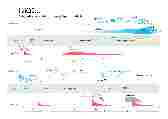Lài Qu ...
- for zheng and live-electronics
- Duration: approx. 12 min.
- 2001 composed by Yueyang Wang and Andre Bartetzki
Lài Qu... is a co-composition by the composer and zheng-player Yueyang Wang (Berlin/Beijing) and me.
performances
The piece was premièred during the Kryptonale festival in Berlin 2001.
Yueyang Wang and I performed Lài Qu... together several times in Berlin, at the Randspiele festival and at the ICMC2002 in Gothenburg/Sweden.
At the SICMF2003 Seoul/Korea I played together with JiYeon Koh a version for Korean kayageum and electronic.
A recording of Lài Qu... was published on the ICMC2002 CD (LJCD5232 www.lj-records.se).
media
 |
 |
 |
 |
| Gu-Zheng | Yueyang 1 | Yueyang 2 | graphical score |
Click here for a recording of Lài Qu... (zheng - Yueyang Wang, electronics - Andre Bartetzki):
program notes
The zheng, a 2500 years old zither-like string instrument, is one of the very popular musical instruments in the traditional music of China. Originally, the Gu-zheng consisted of a bamboo frame and 5 soft-sounding silk strings, which are now replaced by modern nylon strings. The tuning is pentatonic: DO RE MI SO LA. The ambitus was mainly extended to lower notes, a modern concert instrument has 21 to 25 strings. Every string has its own moveable brigde, whose height allows extended vibrato and bending techniques which are typical for the traditional music.
The zheng’s relatives are the Japanese koto, the Vietnamese dan tranh and the Korean kayageum.
Lài Qu ... (pronounced: lie chü) combines traditional with unconventional playing techniques on this instrument.
During the performance of the piece the zheng sounds get processed in real-time by a software written in the SuperCollider language on a Macintosh computer. Some pre-produced sound files, most of them are also derived from the instrument, complete the process.
The linear melodies of the zheng and the vertical spectra of the electronic sounds act as various colors and drawing styles like in an abstract landscape. Whereas the multi-channel electronics widen the space of the instrument so that it surrounds the audience. Or is it the other way round – does the travel go inside?
realization notes
The zheng has to be miked with a contact mic on the top and an additional condenser cardioid over the strings.
The sounds are processed on an Apple Powerbook with SuperCollider. There are some additional pre-produced soundfiles played also by this program. The sound processing is controlled live via a MIDI faderbox.
Lài Qu ... is an 8-channel piece but could also be performed with only 4 or 6 speakers.
review of the concert at the ICMC2002
ICMC 2002 Concert Reviews
Gothenburg, Sweden
Thursday night, September 19, 2002
This concert was held in the New Örgryte Church, a gorgeous venue dating from the 1880's and renovated in the past decade. Elegant stenciling adorned the walls and ceiling of the interior, but the showpiece was a magnificent reproduction of a 17th-century North German baroque organ rising behind the audience. About 4.7 million EUR went into a collaboration with engineers from nearby Chalmers University of Technology to research and painstakingly reconstruct the instrument by faithfully modeling the principles of the original in order to achieve a historically accurate sound. On stage at the other end of the space, huge battered speakers hung in ominous contrast with this prevailing architectural grace. However, as the curator of the concert remarked, the music, though produced via technological means, all reflected a spiritual or inspiring quality worthy of the edifice.
(...)
Lài Qu by Yueyang Wang and Andre Bartetzki for zheng and electronics also skillfully blended electric and acoustic. The zheng is so subtle that even in the first row it was difficult to discern the unamplified instrument. Wang turned this potential liability to her advantage, working deftly with the microphone and pickup to transform her palette with great sensitivity. For those of us unfamiliar with the zheng, it was often challenging to tell which sounds were generated by the electronics and which were straight acoustic. Overall there was a well-balanced blend of real-time processing augmenting a variety of unique instrumental colors. Some especially arresting moments occurred when Wang rubbed the strings, a very light sound almost like breathing, above a faint atmosphere of deep resonance. The piece developed gradually, growing from delicate beginnings to a large finale, each material consistently flowing into the next in well-paced increments. The result was entrancing until the very end when prerecorded traffic and city noise completely broke the spell. There was no precedent for these sounds, no contextualization for their intrusion, so they simply sounded wrong. Perhaps this was the composer's intent-modern life overwhelms the spirit-but if so, it was executed with such heavy-handedness that it ruined an otherwise wonderful piece.
(...)
Reviewed by John Young & Margaret Schedel
For the complete article see: ICMA - Array